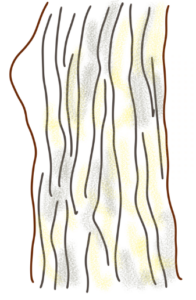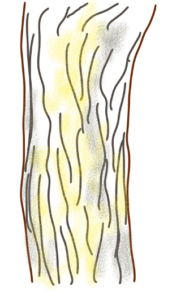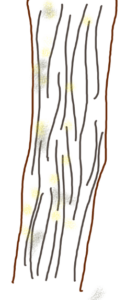Date, Time, and Weather Conditions: September 14th, 2024, Sunny and 22°C
As I was going for my morning walk last week, I noticed that some trees in the neighborhood had yellow and gray crusts forming on their bark. When I stopped to examine one tree, I noticed that while one side of the bark had an abundance of this crust, the other side was relatively clean. As I kept walking, I noticed this pattern among the remaining trees along the street. This compelled me to take some pictures and discover that this was lichen.
In this post, I will focus on the yellow and gray lichens that I’ve observed growing on the bark of trees in the greenspace along Churchill Drive Park, as well as in the nearby residential roads. Specifically, I’ve seen these lichens on American linden and green ash trees along the edge of the park, along Churchill Drive road, as well as on Dutch elm and Siberian elm trees within the neighborhood. I’ve also noticed an abundance of lichen growing on various trees along the walking path closer to the river. I plan to study the distribution of these lichens, noting how their presence and abundance vary across different trees and locations, particularly in relation to sunlight exposure.
Field Observations Along an Environmental Gradient
I recorded my observations across three distinct locations along the environmental gradient of the park and surrounding area:
- Location 1: Greenspace Along the Riverbank
I noticed that there were many trees of various trunk sizes that had an abundance of yellow and gray lichen growing on them. Particularly, the younger Boxelder maples seemed to have a lot of lichen on them despite their small size.
- Location 2: Greenspace Along the Road
Most of the trees planted closer to the road are all similar in size due to being planted around the same time by the city. They are much more mature than the Boxelder maples seen along the riverbank. The two varieties that seem to be planted most frequently are the American linden and green ash trees. Both trees have yellow and gray lichens present.
- Location 3: Residential Streets close to Churchill Drive Park
The elm trees along the residential roads are all very tall and much more mature than the trees in Location 2, likely over 80 years old based on the age of the neighborhood. There is much more tree canopy and shade along most of the residential streets (except for the stretches where trees have been removed due to Dutch elm disease), and I noticed that there were distinctive sides of trees that had lichens present, while other sides had much less lichen.
I’ve included an aerial map outlining the three areas I will be focusing on.

Some sketches recorded on my iPad while observing lichen growth on trees:



Hypothesis and Prediction
Hypothesis: Lichen growth is impacted by direct sunlight, leading to uneven distribution on tree bark.
Prediction: I predict that trees in shaded environments or with trunks facing away from direct sunlight will have less lichen coverage compared to sun-exposed areas.
Variables in Experimental Design
- Categorical Response Variable: Presence of gray or yellow lichen
- Categorical Explanatory Variable: Sunlight exposure (categorical variable, defined as full sun , partial sun/shade , or full shade)
Potential confounding factor Proximity to water, Tree species, Tree age
Great observations and study focus! Your hypothesis and prediction sound great too.